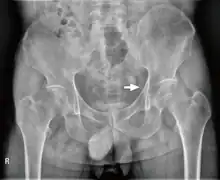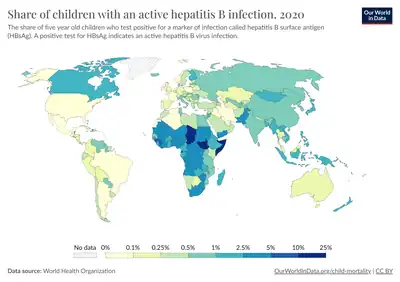Adefovir
 | |
| Names | |
|---|---|
| Trade names | Hepsera |
| Other names | Adefovir dipivoxil |
IUPAC name
| |
| Clinical data | |
| Drug class | Nucleotide analog reverse-transcriptase inhibitor (ntRTI)[1] |
| Main uses | Chronic hepatitis B[2] |
| Side effects | Weakness, diarrhea, abdominal discomfort, headache, nausea, kidney problems[1] |
| WHO AWaRe | UnlinkedWikibase error: ⧼unlinkedwikibase-error-statements-entity-not-set⧽ |
| Pregnancy category |
|
| Routes of use | By mouth |
| External links | |
| AHFS/Drugs.com | Monograph |
| Legal | |
| Legal status | |
| Pharmacokinetics | |
| Bioavailability | 59% |
| Protein binding | <4% |
| Elimination half-life | 7.5 hours |
| Excretion | Urine |
| Chemical and physical data | |
| Formula | C8H12N5O4P |
| Molar mass | 273.189 g·mol−1 |
| 3D model (JSmol) | |
SMILES
| |
InChI
| |
Adefovir, sold under the brand name Hepsera, is a medicine used to treat chronic hepatitis B.[2] It may be used in those over the age of 11.[3] It may be effective in those resistant to lamivudine.[3] It is taken by mouth.[2]
Common side effects include weakness, diarrhea, abdominal discomfort, headache, nausea, and kidney problems.[1] Other side effects may include bone fractures, liver problems, and pancreatitis.[1][3] Safety in pregnancy is unclear.[4] It is a nucleotide analog reverse-transcriptase inhibitor (ntRTI).[1]
Adefovir was approved for medical use in the United States in 2002 and Europe in 2003.[3][5] It is available as a generic medication.[2] In the United Kingdom a month of medication costs the NHS about £250 as of 2021.[1] This amount in the United States costs about 800 USD.[6]
Medical uses
It is used for treatment of hepatitis B.[7][8][9][10]
Trials of adefovir in patients with HIV have not shown benefits.[9][11]
Dosage
It is used at a dose of 10 mg per day in those over the age of 11.[2]
Side effects

Among the adverse or side effects this medication may have on individuals who are administered it are the following:[12]
Mechanism of action

Adefovir works by blocking reverse transcriptase, an enzyme crucial for the HBV to reproduce in the body. It is approved for the treatment of chronic hepatitis B in adults with evidence of active viral replication and either evidence of persistent elevations in serum aminotransferases (primarily ALT) or histologically active disease.
The main benefit of adefovir over lamivudine (the first NRTI approved for the treatment of HBV) is that it takes a much longer period of time for the virus to develop resistance to it.
Adefovir dipivoxil contains two pivaloyloxymethyl units, making it a prodrug form of adefovir.
History

Adefovir was invented in the Institute of Organic Chemistry and Biochemistry, Academy of Sciences of the Czech Republic by Antonín Holý, and the drug was developed by Gilead Sciences for HIV with the brand name Preveon. However, in November 1999, an expert panel advised the U.S. Food and Drug Administration (FDA) not to approve the drug due to concerns about the severity and frequency of kidney toxicity when dosed at 60 or 120 mg. The FDA followed that advice, refusing to approve adefovir as a treatment for HIV.
Gilead Sciences discontinued its development for HIV treatment in December 1999, but continued to develop the drug for hepatitis B (HBV), where it is effective with a much lower dose of 10 mg. FDA approval for use in the treatment of hepatitis B was granted on September 20, 2002, and adefovir is sold for this indication under the brand name Hepsera. Adefovir became an approved treatment for HBV in the European Union in March 2003.[5]
Names
A prodrug form of adefovir was previously called bis-POM PMEA, with trade names Preveon and Hepsera. It can be formulated as the pivoxil prodrug adefovir dipivoxil.
References
- 1 2 3 4 5 6 BNF 81: March-September 2021. BMJ Group and the Pharmaceutical Press. 2021. p. 663. ISBN 978-0857114105.
- 1 2 3 4 5 "Adefovir". LiverTox: Clinical and Research Information on Drug-Induced Liver Injury. National Institute of Diabetes and Digestive and Kidney Diseases. 2012. Archived from the original on 13 January 2022. Retrieved 13 January 2022.
- 1 2 3 4 "Adefovir Monograph for Professionals". Drugs.com. Archived from the original on 28 January 2021. Retrieved 13 January 2022.
- ↑ "Adefovir (Hepsera) Use During Pregnancy". Drugs.com. Archived from the original on 21 October 2020. Retrieved 13 January 2022.
- 1 2 "Hepsera". Archived from the original on 19 April 2021. Retrieved 13 January 2022.
- ↑ "Adefovir Prices, Coupons & Savings Tips - GoodRx". GoodRx. Archived from the original on 19 August 2016. Retrieved 13 January 2022.
- ↑ Marcellin P, Chang TT, Lim SG, Tong MJ, Sievert W, Shiffman ML, et al. (February 2003). "Adefovir dipivoxil for the treatment of hepatitis B e antigen-positive chronic hepatitis B". The New England Journal of Medicine. 348 (9): 808–16. doi:10.1056/NEJMoa020681. PMID 12606735. Archived from the original on 2020-10-28. Retrieved 2020-12-31.
- ↑ Manolakopoulos S, Bethanis S, Koutsounas S, Goulis J, Vlachogiannakos J, Christias E, et al. (February 2008). "Long-term therapy with adefovir dipivoxil in hepatitis B e antigen-negative patients developing resistance to lamivudine". Alimentary Pharmacology & Therapeutics. 27 (3): 266–73. doi:10.1111/j.1365-2036.2007.03567.x. PMID 17988233.
- 1 2 ADHOC International Steering Committee (October 2002). "A randomized placebo-controlled trial of adefovir dipivoxil in advanced HIV infection: the ADHOC trial". HIV Medicine. 3 (4): 229–38. doi:10.1046/j.1468-1293.2002.00111.x. PMID 12444940.
- ↑ "US Adefovir Dipivoxil label" (PDF). FDA. April 2013. Archived (PDF) from the original on 13 February 2017. Retrieved 12 February 2017.
- ↑ Fisher EJ, Chaloner K, Cohn DL, Grant LB, Alston B, Brosgart CL, et al. (September 2001). "The safety and efficacy of adefovir dipivoxil in patients with advanced HIV disease: a randomized, placebo-controlled trial". AIDS. 15 (13): 1695–700. doi:10.1097/00002030-200109070-00013. PMID 11546945.
- ↑ "Adefovir Uses, Side Effects & Warnings". Drugs.com. Archived from the original on 1 December 2020. Retrieved 15 January 2022.
External links
| Identifiers: |
|---|